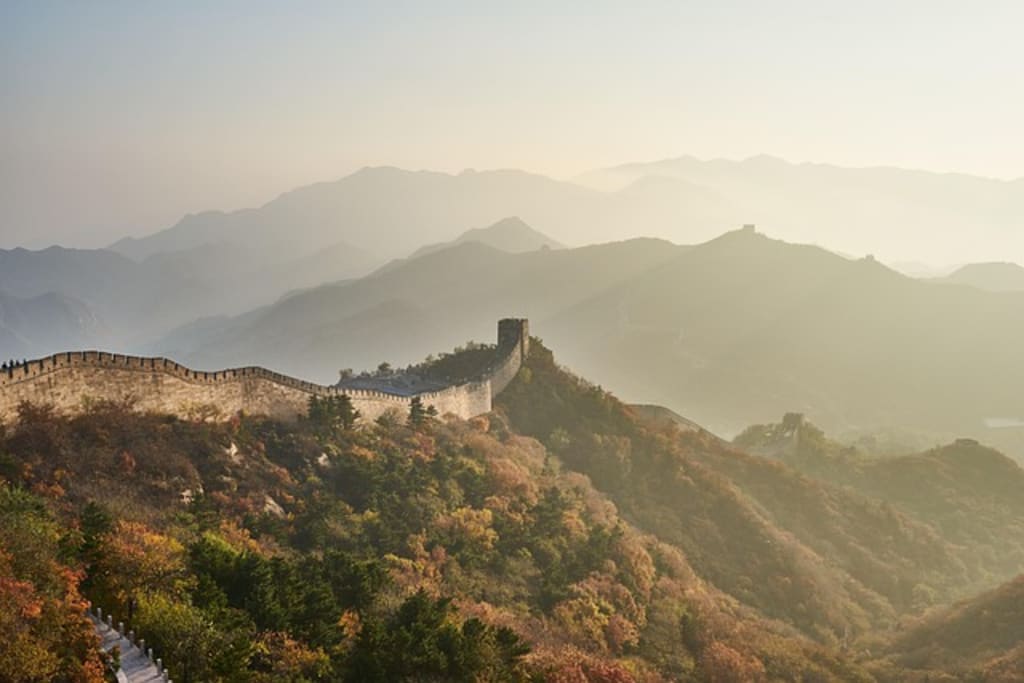
The Great Wall of China is a monumental feat of engineering and one of the most iconic landmarks in the world. Spanning over 13,000 miles, the wall stretches across China's northern border, through the mountains, and across the vast grasslands. The wall is one of the largest and most complex fortifications ever built and is a testament to the ingenuity and determination of the Chinese people.
Construction of the Great Wall of China began over 2,000 years ago, during the Warring States period of China's history. The wall was originally built as a series of fortifications along China's northern border to protect against invasions from nomadic tribes, such as the Mongols and the Manchus. Over time, the wall was expanded and rebuilt by successive dynasties, each adding their own unique features and styles to the wall.
The Great Wall is not a single continuous wall but rather a series of walls, watchtowers, and fortifications that were built over the centuries. The walls were constructed using a variety of materials, including brick, tamped earth, and stone. The height and width of the walls vary depending on the section, with some parts of the wall measuring up to 26 feet tall and 39 feet wide.
One of the most impressive features of the Great Wall is the watchtowers that were built along the wall. These watchtowers were used to spot and signal any approaching enemies, and they were strategically placed at key points along the wall. The watchtowers were built using a combination of brick and stone, and many of them have stood the test of time, despite being over 2,000 years old.
Another important feature of the Great Wall is the fortresses that were built along the wall. These fortresses served as military outposts and provided additional protection to the wall. The fortresses were strategically placed along the wall and were designed to be self-sufficient, with their own water supply, living quarters, and storage facilities.
Despite its impressive size and complexity, the Great Wall was not impenetrable. The wall was breached several times throughout its history, with the most notable breach occurring during the Yuan dynasty, when the Mongols successfully breached the wall and conquered China. However, the wall served as a valuable defense against invading armies and played a crucial role in protecting China's northern borders.
Today, the Great Wall of China is one of the most popular tourist attractions in the world. Visitors from all over the globe come to see the wall and marvel at its size and beauty. The wall is also a symbol of Chinese culture and history and is a source of national pride for the Chinese people.
However, despite its popularity and significance, the Great Wall of China is facing several challenges. One of the biggest challenges facing the wall is the erosion and deterioration of the wall's materials. The wall is exposed to the elements and is subject to erosion from wind, rain, and snow. In addition, the wall is also threatened by human activities, such as graffiti, vandalism, and uncontrolled tourism.
To address these challenges, the Chinese government has launched several initiatives to preserve and protect the Great Wall. One of the most notable initiatives is the Great Wall Conservation Program, which was launched in 2006. The program is a joint effort between the Chinese government and international organizations, and it aims to promote the sustainable development and preservation of the Great Wall.
The program includes several key activities, including the restoration and repair of damaged sections of the wall, the implementation of sustainable tourism practices, and the development of educational programs to raise awareness about the importance of the Great Wall. The program has been successful in preserving and protecting the wall, and it has helped to ensure that the Great Wall remains a valuable cultural and historical resource for future generations.
In addition to the challenges
Another challenge facing the Great Wall of China is the encroachment of urbanization and development. As China's economy has grown, cities and towns have expanded, and many of them have encroached on the Great Wall. This has led to the destruction of sections of the wall and has put the remaining sections at risk.
To address this challenge, the Chinese government has implemented several measures to protect the Great Wall. In 2006, the Chinese government passed a law that prohibits any development within 500 meters of the Great Wall. In addition, the government has also launched initiatives to restore damaged sections of the wall and to create buffer zones around the wall to protect it from further encroachment.
Another challenge facing the Great Wall of China is the impact of climate change. The wall is already subject to erosion and deterioration from natural forces, such as wind and rain, and the effects of climate change, such as rising sea levels and increased temperatures, could exacerbate these problems.
To address the impact of climate change on the Great Wall, the Chinese government has launched several initiatives to reduce greenhouse gas emissions and promote sustainable development. These initiatives include the development of renewable energy sources, such as wind and solar power, and the promotion of energy-efficient technologies.
Despite these challenges, the Great Wall of China remains a symbol of China's rich cultural heritage and a testament to the ingenuity and determination of the Chinese people. The wall is a valuable resource for historians, architects, and engineers, and it serves as a reminder of the important role that China has played in world history.
Visitors to the Great Wall of China can explore many different sections of the wall, each with its own unique features and characteristics. Some sections are easily accessible and well-maintained, while others are more remote and require a bit of hiking to reach. Popular sections of the wall include the Badaling section, which is the most popular and well-maintained section of the wall, and the Mutianyu section, which offers breathtaking views of the surrounding mountains.
In addition to exploring the wall itself, visitors to the Great Wall of China can also learn about the history and culture of the wall at several museums and visitor centers located throughout the region. These museums offer interactive exhibits, multimedia displays, and educational programs that provide a deeper understanding of the history and significance of the wall.
The Great Wall of China is not just a physical structure, but a cultural icon that has come to represent China's rich heritage and identity. The wall has been a source of national pride for centuries, and it continues to serve as a symbol of China's long and storied history.
One of the most fascinating aspects of the Great Wall of China is the incredible engineering feats that were required to build it. The wall was constructed using a variety of materials, including stone, brick, tamped earth, and even human hair and blood. The builders of the wall were able to construct it across vast distances, over difficult terrain, and in hostile environments, using techniques and tools that were advanced for their time.
Despite the impressive engineering of the Great Wall, it was not impervious to attack. Throughout its long history, the wall was breached numerous times by invaders, including the Mongols, Manchus, and Japanese. Despite these setbacks, the wall continued to be an important line of defense for China, and its construction and maintenance were seen as a vital duty of the Chinese government and people.
In addition to its military significance, the Great Wall of China also played an important role in China's cultural and economic development. The wall served as a transportation route for goods and people, as well as a barrier to the spread of disease and other negative influences. The wall also provided a framework for cultural exchange, as travelers from all over the world passed through the gates and along the wall, sharing stories, ideas, and goods.
Today, the Great Wall of China remains one of the most visited tourist attractions in the world, attracting millions of visitors each year. The wall is a source of inspiration for artists, writers, and filmmakers, and it continues to be a symbol of China's cultural heritage and identity.
One of the most popular ways to experience the Great Wall of China is by taking a guided tour. Guided tours can offer visitors a deeper understanding of the history and culture of the wall, as well as access to some of the most interesting and scenic sections of the wall. Many tour operators offer customized tours that can be tailored to suit the interests and needs of individual travelers.
For those who prefer to explore the wall on their own, there are many resources available to help plan a trip. Travel guides, websites, and blogs can provide valuable information about the best sections of the wall to visit, as well as tips for navigating the wall and staying safe while on the trail.
No matter how visitors choose to experience the Great Wall of China, one thing is certain: it is a remarkable testament to the ingenuity, perseverance, and cultural heritage of the Chinese people. The wall's massive scale, stunning beauty, and rich history continue to inspire and captivate visitors from around the world, and it remains one of the most enduring and iconic landmarks in human history.
The Great Wall of China has also been the subject of much research and academic study over the years. Scholars from all over the world have studied the wall's history, construction, and cultural significance, contributing to a growing body of knowledge about this remarkable structure.
One area of research that has received particular attention in recent years is the impact of the Great Wall of China on the environment. The wall was constructed using a variety of materials, including timber and soil, which were extracted from the surrounding area. As a result, the wall had a significant impact on the local environment, causing deforestation, soil erosion, and habitat loss.
To address these environmental concerns, the Chinese government has launched several initiatives to protect and restore the areas around the Great Wall. These initiatives include reforestation efforts, soil conservation programs, and the creation of nature reserves and protected areas. By working to mitigate the impact of the Great Wall on the environment, the Chinese government is helping to ensure that this remarkable structure can be enjoyed by future generations.
In addition to its environmental impact, the Great Wall of China has also been the subject of controversy and debate. Some critics have argued that the wall is a symbol of China's oppressive past and should be torn down, while others have defended the wall as a vital part of China's cultural heritage.
Despite these controversies, the Great Wall of China remains a source of pride and inspiration for the Chinese people, as well as a valuable resource for historians, architects, and engineers.
conclusion:
In conclusion, the Great Wall of China is one of the most impressive and iconic landmarks in the world. Spanning over 13,000 miles, the wall is a testament to the ingenuity and determination of the Chinese people and a symbol of China's rich cultural heritage. While the wall is facing several challenges, including erosion, development, and climate change, the Chinese government has implemented several initiatives to preserve and protect the wall for future generations. Visitors to the Great Wall of China can explore many different sections of the wall and learn about the history and culture of this remarkable structure.
About the Creator
Enjoyed the story? Support the Creator.
Subscribe for free to receive all their stories in your feed. You could also pledge your support or give them a one-off tip, letting them know you appreciate their work.






Comments
There are no comments for this story
Be the first to respond and start the conversation.